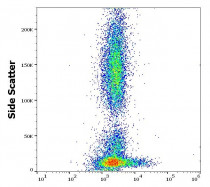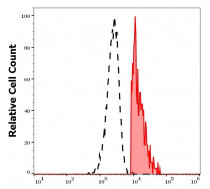ARG57575
anti-CD279 / PD-1 antibody [EH12.2H7] (low endotoxin)
anti-CD279 / PD-1 antibody [EH12.2H7] (low endotoxin) for CyTOF®-candidate,Flow cytometry,Functional study,IHC-Frozen sections and Human,Primates
Overview
| Product Description | Azide free and low endotoxin Mouse Monoclonal antibody [EH12.2H7] recognizes CD279 / PD-1 |
|---|---|
| Tested Reactivity | Hu, NHuPrm |
| Tested Application | CyTOF®-candidate, FACS, FuncSt, IHC-Fr |
| Specificity | The antibody recognizes CD279 / PD-1 (programmed cell death 1), a 55 kDa type I transmembrane protein expressed above all during T cell development, on activated T cells, activated B cells, and activated monocytes. |
| Host | Mouse |
| Clonality | Monoclonal |
| Clone | EH12.2H7 |
| Isotype | IgG1 |
| Target Name | CD279 / PD-1 |
| Antigen Species | Human |
| Conjugation | Un-conjugated |
| Alternate Names | hPD-l; CD279; PD-1; Protein PD-1; CD antigen CD279; PD1; hSLE1; SLEB2; Programmed cell death protein 1; hPD-1 |
Application Instructions
| Application Suggestion |
|
||||||||||
|---|---|---|---|---|---|---|---|---|---|---|---|
| Application Note | Functional study: The clone EH12.2H7 could be used to block the ligand binding. * The dilutions indicate recommended starting dilutions and the optimal dilutions or concentrations should be determined by the scientist. |
Properties
| Form | Liquid |
|---|---|
| Purification | Purification with Protein A. |
| Purification Note | 0.2 µm filter sterilized. Endotoxin level is <0.01 EU/µg of the protein, as determined by the LAL test. |
| Purity | > 95% (by SDS-PAGE) |
| Buffer | PBS (pH 7.4) |
| Concentration | 1 mg/ml |
| Storage Instruction | For continuous use, store undiluted antibody at 2-8°C for up to a week. For long-term storage, aliquot and store at -20°C or below. Storage in frost free freezers is not recommended. Avoid repeated freeze/thaw cycles. Suggest spin the vial prior to opening. The antibody solution should be gently mixed before use. |
| Note | For laboratory research only, not for drug, diagnostic or other use. |
Bioinformation
| Database Links | |
|---|---|
| Gene Symbol | PDCD1 |
| Gene Full Name | PDCD1 |
| Background | CD279 / PD-1 is a cell surface membrane protein of the immunoglobulin superfamily. This protein is expressed in pro-B-cells and is thought to play a role in their differentiation. In mice, expression of this gene is induced in the thymus when anti-CD3 antibodies are injected and large numbers of thymocytes undergo apoptosis. Mice deficient for this gene bred on a BALB/c background developed dilated cardiomyopathy and died from congestive heart failure. These studies suggest that this gene product may also be important in T cell function and contribute to the prevention of autoimmune diseases. [provided by RefSeq, Jul 2008] |
| Function | CD279 / PD-1 is an inhibitory receptor on antigen activated T-cells. It plays a critical role in induction and maintenance of immune tolerance to self (PubMed:21276005). Delivers inhibitory signals upon binding to ligands CD274/PDCD1L1 and CD273/PDCD1LG2 (PubMed:21276005). Following T-cell receptor (TCR) engagement, PDCD1 associates with CD3-TCR in the immunological synapse and directly inhibits T-cell activation. Suppresses T-cell activation through the recruitment of PTPN11/SHP-2: following ligand-binding, PDCD1 is phosphorylated within the ITSM motif, leading to the recruitment of the protein tyrosine phosphatase PTPN11/SHP-2 that mediates dephosphorylation of key TCR proximal signaling molecules, such as ZAP70, PRKCQ/PKCtheta and CD247/CD3zeta. The PDCD1-mediated inhibitory pathway is exploited by tumors to attenuate anti-tumor immunity and escape destruction by the immune system, thereby facilitating tumor survival (PubMed:28951311). The interaction with CD274/PDCD1L1 inhibits cytotoxic T lymphocytes (CTLs) effector function (PubMed:28951311). The blockage of the PDCD1-mediated pathway results in the reversal of the exhausted T-cell phenotype and the normalization of the anti-tumor response, providing a rationale for cancer immunotherapy (PubMed:22658127, PubMed:25034862, PubMed:25399552). [UniProt] |
| Cellular Localization | Membrane |
| Highlight | Related products: PD-1 antibodies; PD-1 ELISA Kits; PD-1 Duos / Panels; Anti-Mouse IgG secondary antibodies; Related news: CyTOF-candidate Antibodies The best solution for PD-1/PD-L1 research Examining CTL/NK-mediated cytotoxicity by ELISA |
| Calculated MW | 32 kDa |
Images (2) Click the Picture to Zoom In
-
ARG57575 anti-CD279 / PD-1 antibody [EH12.2H7] (low endotoxin) FACS image
Flow Cytometry: Human peripheral blood stained with ARG57575 anti-CD279 / PD-1 antibody [EH12.2H7] (low endotoxin) at 6 µg/ml dilution, followed by APC-conjugated Goat anti-Mouse antibody.
-
ARG57575 anti-CD279 / PD-1 antibody [EH12.2H7] (low endotoxin) FACS image
Flow Cytometry: Separation of human CD279 positive lymphocytes (red-filled) from neutrophil granulocytes (black-dashed). Human peripheral whole blood stained with ARG57575 anti-CD279 / PD-1 antibody [EH12.2H7] (low endotoxin) at 6 µg/ml dilution, followed by APC-conjugated Goat anti-Mouse antibody.







